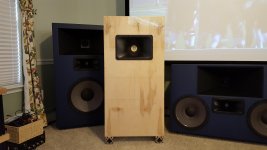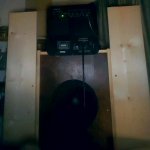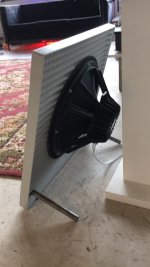It's quite easy to try out different targets with Audiolense, so i haven't landed on a final one yet.
i might reduce the downward slope a bit and go a bit flatter now that i have the diffusers on the rear wall, as it has smoothed out the sound a bit compared to having a bare wall behind the speakers.
i might reduce the downward slope a bit and go a bit flatter now that i have the diffusers on the rear wall, as it has smoothed out the sound a bit compared to having a bare wall behind the speakers.
Wow, some of these OB projects are amazing.
Here is my Yield OB project.
Uses Audio Nirvana Super 10 and a pair of Alpha 15's.
Dave
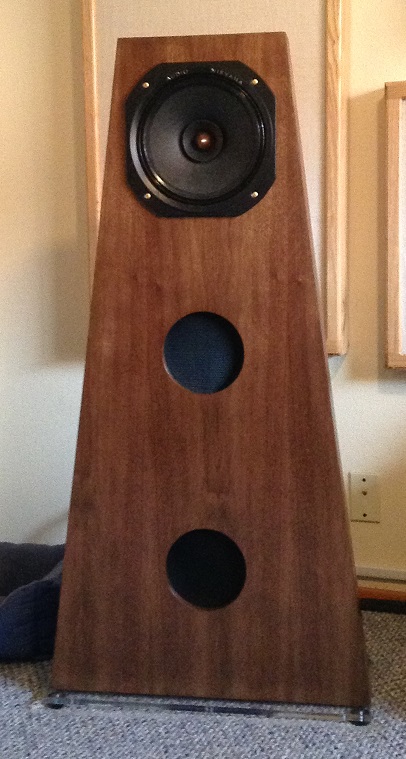
Dave,
How tall are these speakers? What is the width at the base?
Very nice setup bjarnetv 🙂
Looking forward to have a listen soon.
I am testing your Visaton B200 tonight before you get them back.
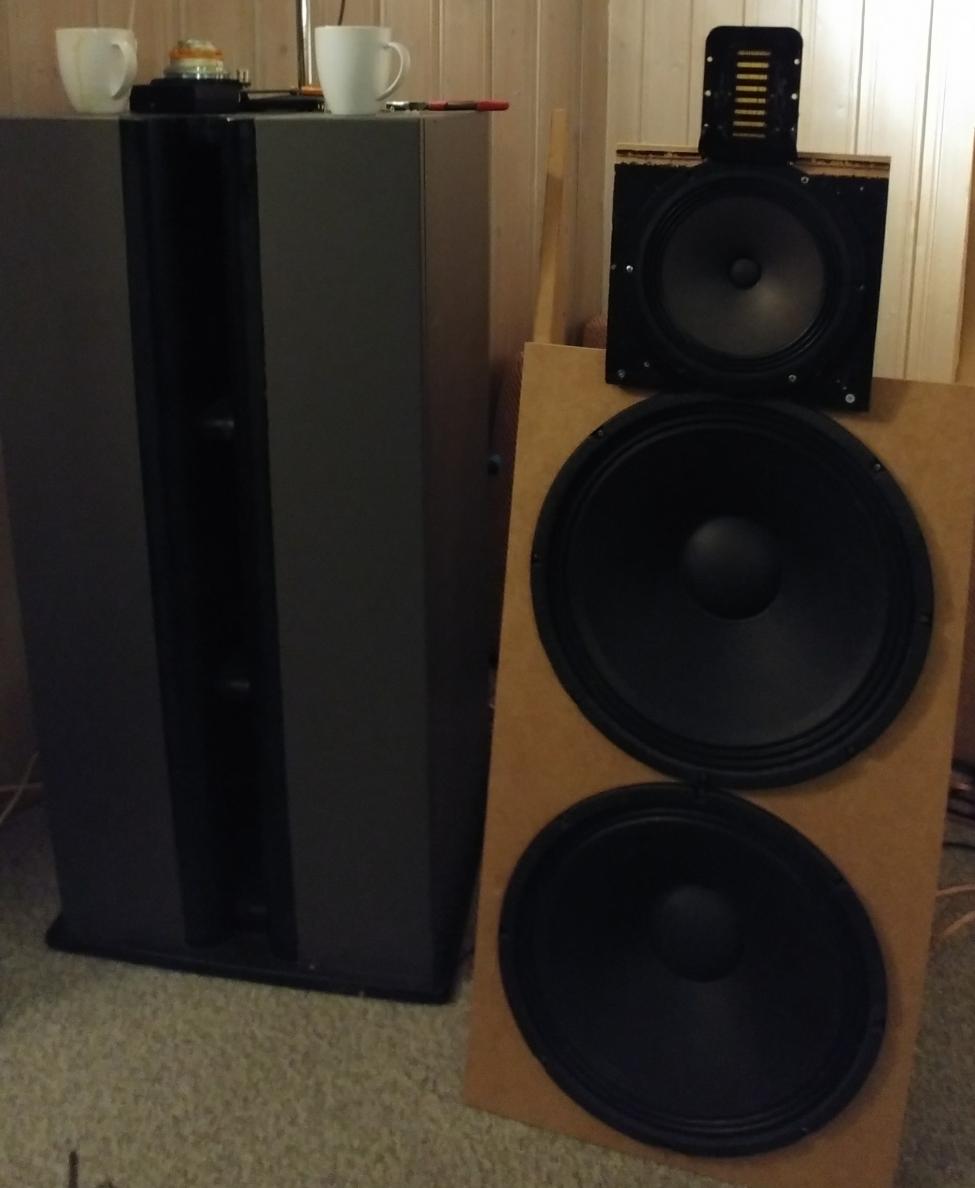
Looking forward to have a listen soon.
I am testing your Visaton B200 tonight before you get them back.

It's very easy and simple to get superior sound with open baffle and Audiolense.
I've been building 20-25 mockups the last 2-3 month's with different designs and drivers.
Learning a lot on this "maraton".
Very fun.
Sorry my bad english.
I've been building 20-25 mockups the last 2-3 month's with different designs and drivers.
Learning a lot on this "maraton".
Very fun.
Sorry my bad english.
These are mine.
They are stone laminated. It's 6mm of a stone called Blue Barracuda, 6mm of honeycombed aluminium, 18mm of plywood, 6mm alu and 6mm stone for the backside as well. Keeps the whole thing well damped, and they weight about 22kg each.
Very pleased with the looks.
I'm using active filters with a miniDSP HD for the XO.
Very nice!!!
four years later, and i'm still using the same speakers - i guess that counts as a success 😀
Congratulations... Did we reach Nirvana at the same time ? 🙂
These are my speakers and still living and breathing until today where the rest became firewood!
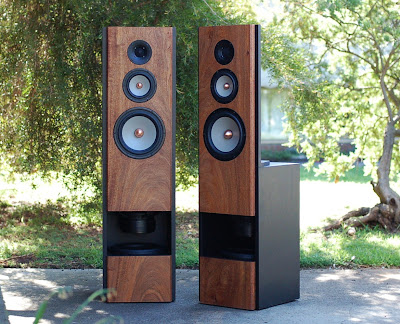
It was built in 2/9/2012 (whoa!) and I wrote in my note:
"Update 23/1/13 - I have been living for quite a while with these speakers. I havent' had any desires to build something new ! "
I picked up my old hobby buying and restoring old bikes. Different kind of 'music' and gets me out of the house lol ...
: :: GPZ900R-A7 & GPZ750-R1
Congratulations... Did we reach Nirvana at the same time ? 🙂
These are my speakers and still living and breathing until today where the rest became firewood!
It was built in 2/9/2012 (whoa!) and I wrote in my note:
"Update 23/1/13 - I have been living for quite a while with these speakers. I havent' had any desires to build something new ! "
I picked up my old hobby buying and restoring old bikes. Different kind of 'music' and gets me out of the house lol ...
: :: GPZ900R-A7 & GPZ750-R1
Yeah, those were the days when open baffles and controlled dispersion was all the rage 😀
i remember reading through your blog and all the other "open baffle sites" when designing my speakers, and it was real exciting how easy it had become trying out different baffle designs, cardioid vs dipole, etc, due to the emergence of cheap dsp and measurement mics.
i have to admit though, i was never totally happy with the crossovers before moving to a more powerful DSP platform than the minidsp 4x10, and i was often tempted to start anew with something requiring bit less EQ.
i kind of wondered what happened since you stopped building more speakers, so i'm glad to hear that the reason was you being content with your design.
if you haven't yet, you should really try out some advanced TTD dsp yourself though. 😉
the difference compared to regular frequency response XO is pretty mind-boggling.
There's a bunch of norwegian DIY'ers, including myself that just transitioned to Audiolense, and i think we're all pretty happy we took the plunge, even though there was quite a bit of suffering for those of us transitioning from a itunes/mac to a jriver/windows based playback chain

Yeah, those were the days when open baffles and controlled dispersion was all the rage 😀
i remember reading through your blog and all the other "open baffle sites" when designing my speakers, and it was real exciting how easy it had become trying out different baffle designs, cardioid vs dipole, etc, due to the emergence of cheap dsp and measurement mics.
i have to admit though, i was never totally happy with the crossovers before moving to a more powerful DSP platform than the minidsp 4x10, and i was often tempted to start anew with something requiring bit less EQ.
i kind of wondered what happened since you stopped building more speakers, so i'm glad to hear that the reason was you being content with your design.
if you haven't yet, you should really try out some advanced TTD dsp yourself though. 😉
the difference compared to regular frequency response XO is pretty mind-boggling.
There's a bunch of norwegian DIY'ers, including myself that just transitioned to Audiolense, and i think we're all pretty happy we took the plunge, even though there was quite a bit of suffering for those of us transitioning from a itunes/mac to a jriver/windows based playback chain
what is in your hardware chain? (sound card etc.?)
what is in your hardware chain? (sound card etc.?)
I run everything through Jriver on a win10 computer, with correction filters from audiolense in the convolution engine.
connected to it is a Lynx Aurora 8 soundcard, that sends the signal to a 2ch Holton nxv101 r2 for the tweeters, Holton nxv300 r2 monoblocks for the mids, a Sumo Andromeda I for the bass, and finally a rotel rb1510 for the TH subs.
I have the parts for a Holton nxv500r2 laying around to replace the Sumo, but i never seem to find the time to put it together...
The Sumo sounds pretty good though, so there is no rush. 😱
The two turntables are connected to a Graham Slee reflex M/elevator EXP combo, and are equipped with a AT33ptg/II on the Technics SP10, and an AT33 mono on the Sony TTS3000.
They are of course connected to the Aurora, and routed through Jriver via the LIVE IN function.
Last edited:
Building my first pair of open baffle speakers. For testing I am starting with the following:
1) MarkAudio CHP-70-P Gen 2 Natural
2) JBL Pro PRX700 horn (4" throat)
3) 24" x 48" x .75" plywood
4) JBL Pro 2123H 10" midrange
5) Eminence Delta-10A 10"
6) JBL Pro 2226H 15"
7) Pi Speakers H290C HF horn (1" throat)
8) B&C DE250 compression
Items 2, 4, 5, 6, 7 and 8 are leftovers from previous builds.
Have played around with Basta program over past few weeks, will see how models compare with reality.
I really like horns, my main home theater speakers have horn HF and Mid, crossed over to a JBL Pro 2242 18" driver for bass. Each speakers weighs around 250 lbs. The Auto-tech horns look really nice, lots of builds with them paired with Lowther drivers. Since no one in the US carries the horns I decided to use a spare JBL midhorn with an inexpensive full range driver.
Here it is so far....
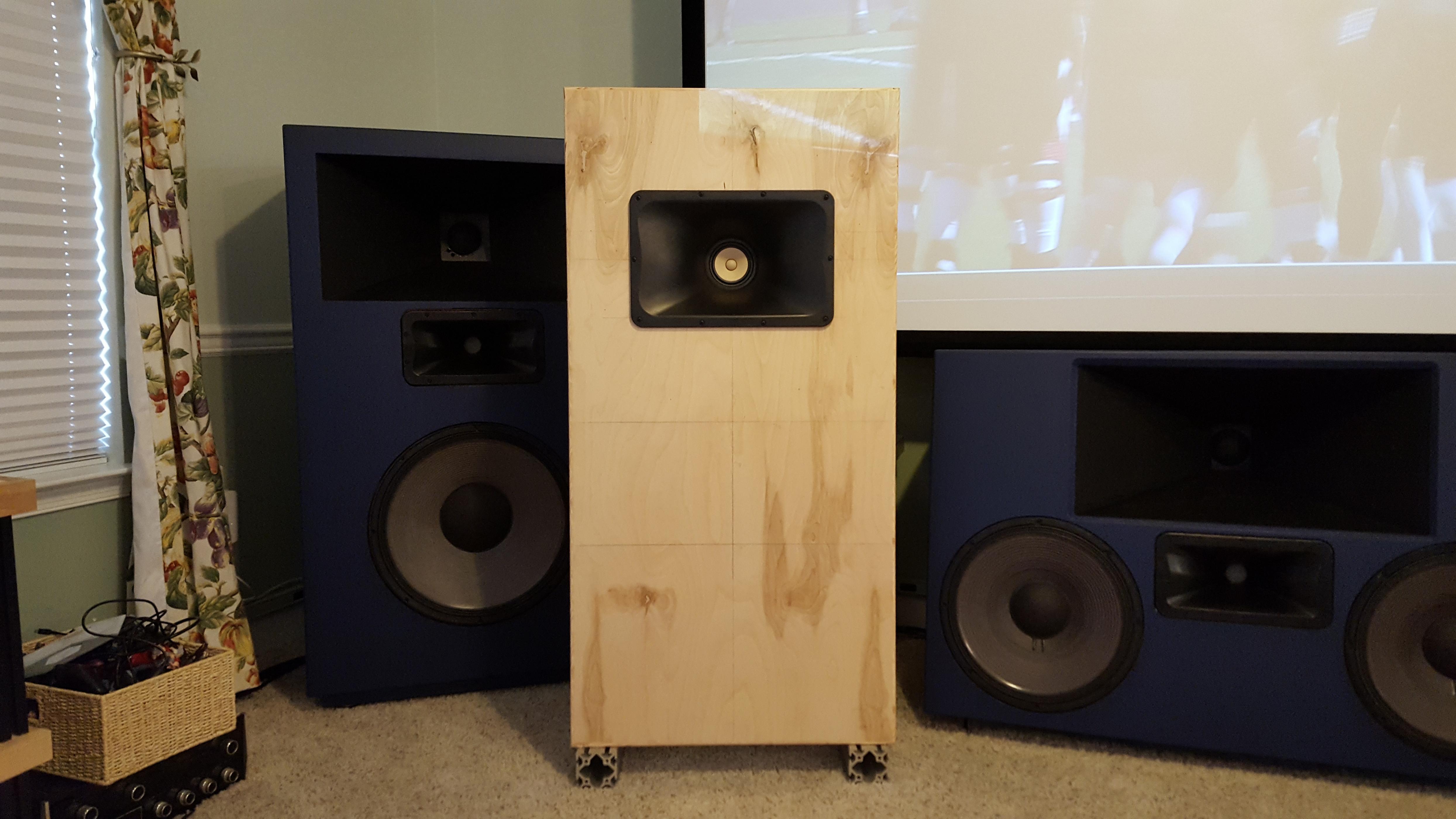
1) MarkAudio CHP-70-P Gen 2 Natural
2) JBL Pro PRX700 horn (4" throat)
3) 24" x 48" x .75" plywood
4) JBL Pro 2123H 10" midrange
5) Eminence Delta-10A 10"
6) JBL Pro 2226H 15"
7) Pi Speakers H290C HF horn (1" throat)
8) B&C DE250 compression
Items 2, 4, 5, 6, 7 and 8 are leftovers from previous builds.
Have played around with Basta program over past few weeks, will see how models compare with reality.
I really like horns, my main home theater speakers have horn HF and Mid, crossed over to a JBL Pro 2242 18" driver for bass. Each speakers weighs around 250 lbs. The Auto-tech horns look really nice, lots of builds with them paired with Lowther drivers. Since no one in the US carries the horns I decided to use a spare JBL midhorn with an inexpensive full range driver.
Here it is so far....
Attachments
Gainphile, your projects were big inspiration for me too!
John Reekie, Rudolf Finke, John Kreskowitz , Siegfried Linkwitz and Jorma Salmi too of course.
AINOgradients are still going strong with minidsp and ICEPower classD
John Reekie, Rudolf Finke, John Kreskowitz , Siegfried Linkwitz and Jorma Salmi too of course.
AINOgradients are still going strong with minidsp and ICEPower classD
Great to hear bjarnetv. Gave me something to think about
Juhazi, thanks but don't tell me you haven't built anything new either 😀
We need IDEAS it seems the OB's had been done to death now with so many commercial offerings too! A far cry in the days of Phoenix and Orions !!! Which is a good thing in its own regards
Juhazi, thanks but don't tell me you haven't built anything new either 😀
We need IDEAS it seems the OB's had been done to death now with so many commercial offerings too! A far cry in the days of Phoenix and Orions !!! Which is a good thing in its own regards
Ive gone back to Onkens with midrange horns, for the most part, but still prefer dipole bass.
This past weekend, I swapped out 4 Dayton RSS265HF-4 sub drivers, medium qts of 0.44, for some inexpensive GRS 10PR-8 polycones, with a 1.15 qts.
I know a higher qts should give better bass on an open baffle, but I had not expected this much.
At a lower volume setting on the plate amp, and wired for an 8 ohm load, rather than 4 ohms, even.
With the lower Qts Daytons, I could see the drivers moving a total of a half inch travel, with less audible output than the cheap GRS drivers, which barely move at higher volume levels.
What's going on? Shouldn't larger displacement play louder?
The drivers are in a u frame, 11.25" deep, 16" wide, 72" tall, with 7.25 " wide extensions on each side, making a wider baffle.
This past weekend, I swapped out 4 Dayton RSS265HF-4 sub drivers, medium qts of 0.44, for some inexpensive GRS 10PR-8 polycones, with a 1.15 qts.
I know a higher qts should give better bass on an open baffle, but I had not expected this much.
At a lower volume setting on the plate amp, and wired for an 8 ohm load, rather than 4 ohms, even.
With the lower Qts Daytons, I could see the drivers moving a total of a half inch travel, with less audible output than the cheap GRS drivers, which barely move at higher volume levels.
What's going on? Shouldn't larger displacement play louder?
The drivers are in a u frame, 11.25" deep, 16" wide, 72" tall, with 7.25 " wide extensions on each side, making a wider baffle.
Attachments
Ive gone back to Onkens with midrange horns, for the most part, but still prefer dipole bass.
This past weekend, I swapped out 4 Dayton RSS265HF-4 sub drivers, medium qts of 0.44, for some inexpensive GRS 10PR-8 polycones, with a 1.15 qts.
I know a higher qts should give better bass on an open baffle, but I had not expected this much.
At a lower volume setting on the plate amp, and wired for an 8 ohm load, rather than 4 ohms, even.
With the lower Qts Daytons, I could see the drivers moving a total of a half inch travel, with less audible output than the cheap GRS drivers, which barely move at higher volume levels.
What's going on? Shouldn't larger displacement play louder?
The drivers are in a u frame, 11.25" deep, 16" wide, 72" tall, with 7.25 " wide extensions on each side, making a wider baffle.
Keep listening. Once you get over the "free" extra bass provided by the high QTS drivers, you may notice that it's less defined and more one-note bassy. I certainly did and went back to a lower Q driver, but I'm only trying to get to 60Hz solid, not all the way down.
Greg
Keep listening. Once you get over the "free" extra bass provided by the high QTS drivers, you may notice that it's less defined and more one-note bassy. I certainly did and went back to a lower Q driver, but I'm only trying to get to 60Hz solid, not all the way down.
Greg
I really agree with you. In my room the room gain also helps me, making low Qts go deep and with much more definition and dynamics. I'm currently using 15" PHL audio woofers with unknown TS parameters, but I presume very low Qts (for what's commonly seen as OB drivers). I'm very pleased with both sensitivity, bass output and dynamics. The membranes barely move even when I play very loud, witch I do.
Last edited:
I recently build these for fun, but I think they sound better than my H-frames.
Driver is a faital pro 15pr400 mounted on a steel ventilation floor piece I found. It's pretty heavy and there is not a lot of resonance of the baffle. I lasercutted a spacer so the conus doesn't hit the steel.
Driver is a faital pro 15pr400 mounted on a steel ventilation floor piece I found. It's pretty heavy and there is not a lot of resonance of the baffle. I lasercutted a spacer so the conus doesn't hit the steel.
Attachments
I like the idea!
With a higher frame you can test different drivers without having to make a new baffle! You can also do diffraction experiments with square plugs (maybe 3d-printed) that fit into the square holes!
When you're happy with the sound, just pull a sock over it!
With a higher frame you can test different drivers without having to make a new baffle! You can also do diffraction experiments with square plugs (maybe 3d-printed) that fit into the square holes!
When you're happy with the sound, just pull a sock over it!
I like the idea!
With a higher frame you can test different drivers without having to make a new baffle! You can also do diffraction experiments with square plugs (maybe 3d-printed) that fit into the square holes!
When you're happy with the sound, just pull a sock over it!
I also tried the Alpha 15. Also sound very good.
Weird thing I hear now when listening louder is a kind of bottoming out sound while I don't get the idea it is reaching x-max. Also could be the tin leads hitting de cone.
The distorion is also pretty low this way!
Attachments
The Alpha 15 has a x-limit of just 3.8 mm or 0.15 inch and and a pretty sloppy 1.15 Qts cone control, which could cause the bottoming out feeling.
The Alpha 15 has a x-limit of just 3.8 mm or 0.15 inch and and a pretty sloppy 1.15 Qts cone control, which could cause the bottoming out feeling.
Ah yeah but it's the faital pro 15pr400 I'm talking about
- Home
- Loudspeakers
- Multi-Way
- Ultimate Open Baffle Gallery
